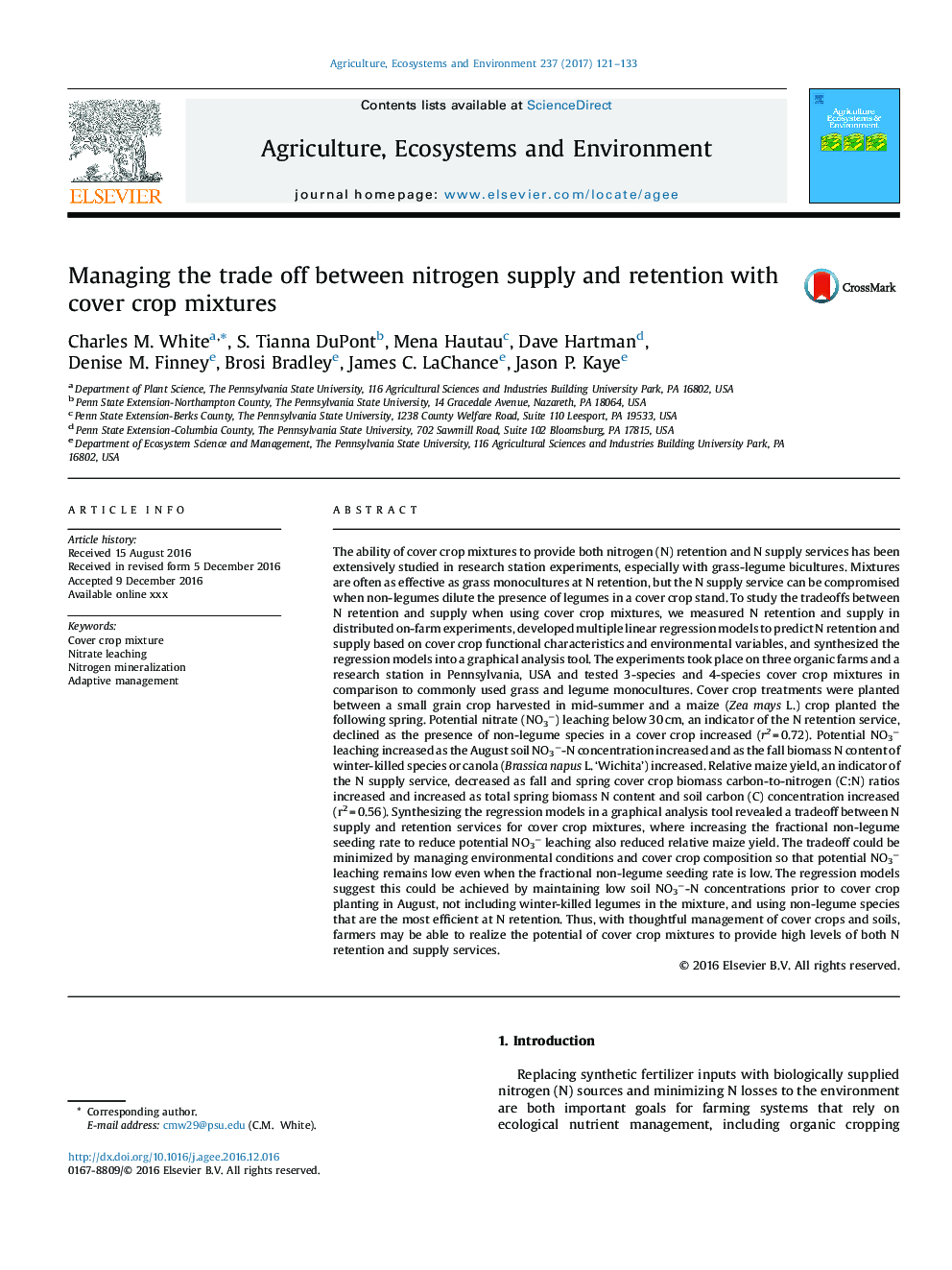| کد مقاله | کد نشریه | سال انتشار | مقاله انگلیسی | نسخه تمام متن |
|---|---|---|---|---|
| 5538225 | 1552015 | 2017 | 13 صفحه PDF | دانلود رایگان |
عنوان انگلیسی مقاله ISI
Managing the trade off between nitrogen supply and retention with cover crop mixtures
ترجمه فارسی عنوان
مدیریت تجارت بین عرضه و نگهداری نیتروژن با مخلوط های مخلوط پوشش
دانلود مقاله + سفارش ترجمه
دانلود مقاله ISI انگلیسی
رایگان برای ایرانیان
کلمات کلیدی
مخلوط محصول را پوشش دهید. اشباع نیترات، کانی سازی نیتروژن، مدیریت انطباقی
موضوعات مرتبط
علوم زیستی و بیوفناوری
علوم کشاورزی و بیولوژیک
علوم زراعت و اصلاح نباتات
چکیده انگلیسی
The ability of cover crop mixtures to provide both nitrogen (N) retention and N supply services has been extensively studied in research station experiments, especially with grass-legume bicultures. Mixtures are often as effective as grass monocultures at N retention, but the N supply service can be compromised when non-legumes dilute the presence of legumes in a cover crop stand. To study the tradeoffs between N retention and supply when using cover crop mixtures, we measured N retention and supply in distributed on-farm experiments, developed multiple linear regression models to predict N retention and supply based on cover crop functional characteristics and environmental variables, and synthesized the regression models into a graphical analysis tool. The experiments took place on three organic farms and a research station in Pennsylvania, USA and tested 3-species and 4-species cover crop mixtures in comparison to commonly used grass and legume monocultures. Cover crop treatments were planted between a small grain crop harvested in mid-summer and a maize (Zea mays L.) crop planted the following spring. Potential nitrate (NO3â) leaching below 30Â cm, an indicator of the N retention service, declined as the presence of non-legume species in a cover crop increased (r2Â =Â 0.72). Potential NO3â leaching increased as the August soil NO3â-N concentration increased and as the fall biomass N content of winter-killed species or canola (Brassica napus L. 'Wichita') increased. Relative maize yield, an indicator of the N supply service, decreased as fall and spring cover crop biomass carbon-to-nitrogen (C:N) ratios increased and increased as total spring biomass N content and soil carbon (C) concentration increased (r2Â =Â 0.56). Synthesizing the regression models in a graphical analysis tool revealed a tradeoff between N supply and retention services for cover crop mixtures, where increasing the fractional non-legume seeding rate to reduce potential NO3â leaching also reduced relative maize yield. The tradeoff could be minimized by managing environmental conditions and cover crop composition so that potential NO3â leaching remains low even when the fractional non-legume seeding rate is low. The regression models suggest this could be achieved by maintaining low soil NO3â-N concentrations prior to cover crop planting in August, not including winter-killed legumes in the mixture, and using non-legume species that are the most efficient at N retention. Thus, with thoughtful management of cover crops and soils, farmers may be able to realize the potential of cover crop mixtures to provide high levels of both N retention and supply services.
ناشر
Database: Elsevier - ScienceDirect (ساینس دایرکت)
Journal: Agriculture, Ecosystems & Environment - Volume 237, 16 January 2017, Pages 121-133
Journal: Agriculture, Ecosystems & Environment - Volume 237, 16 January 2017, Pages 121-133
نویسندگان
Charles M. White, S. Tianna DuPont, Mena Hautau, Dave Hartman, Denise M. Finney, Brosi Bradley, James C. LaChance, Jason P. Kaye,
